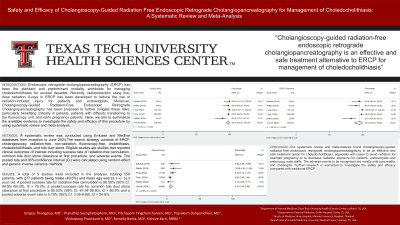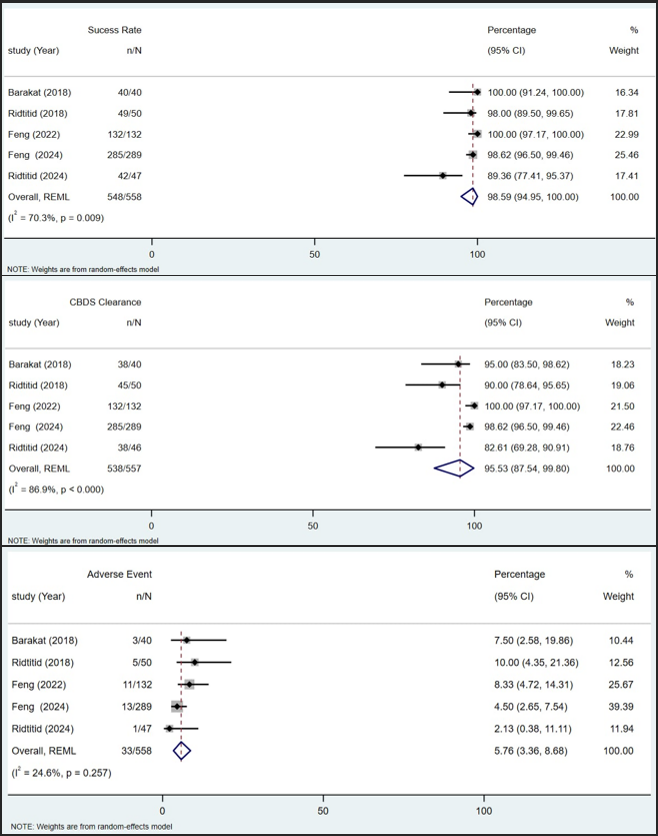Monday Poster Session
Category: Interventional Endoscopy
P2779 - Safety and Efficacy of Cholangioscopy-Guided Radiation Free Endoscopic Retrograde Cholangiopancreatography for Management of Choledocholithiasis: A Systematic Review and Meta-Analysis
Monday, October 28, 2024
10:30 AM - 4:00 PM ET
Location: Exhibit Hall E

Has Audio

Jerapas Thongpiya, MD
Texas Tech University Health Sciences Center
Lubbock, TX
Presenting Author(s)
Jerapas Thongpiya, MD1, Thanathip Suenghataiphorn, MD2, Pitchaporn Yingchoncharoen, MD1, Pojsakorn Danpanichkul, MD1, Vitchapong Prasitsumrit, MD3, Romelia Barba, MD1, Kishore Karri, MBBS, MD4
1Texas Tech University Health Sciences Center, Lubbock, TX; 2Griffin Hospital, Derby, CT; 3Mahidol University, Bangkok, Krung Thep, Thailand; 4University of Kentucky, Lexington, KY
Introduction: Endoscopic retrograde cholangiopancreatography (ERCP) has been the standard and predominant modality worldwide for managing choledocholithiasis for several decades. Recently, radioprotection using low-dose radiation X-rays in ERCP has been developed to reduce the risk of radiation-induced injury for patients and endoscopists. Moreover, Cholangioscopy-Guided Radiation-Free Endoscopic Retrograde Cholangiopancreatography has been proposed to further mitigate these risks, particularly benefiting critically ill patients, patients with difficulty transferring to the fluoroscopy unit, and early pregnancy patients. Here, we aim to summarize the available evidence to investigate the safety and efficacy of this procedure by using systematic review and meta-analysis.
Methods: A systematic review was conducted using Embase and Medline databases from inception to June 2024.The search strategy consists of ERCP, cholangioscopy, radiation-free, non-radiation, fluoroscopy-free, cholelithiasis, choledocholithiasis, and bile duct stone. Eligible studies are studies that reported clinical outcomes of interest including success rate of radiation-free cannulation, common bile duct stone clearance at first procedure, and adverse events. The pooled rate and 95%confidence interval (CI) were calculated using random-effect and generic inverse variance methods.
Results: A total of 5 studies were included in the analysis, totaling 558 patients, with 277 patients being males (49.6%) and mean age was 63.5 +/- 16.9 years old. A pooled success rate for radiation-free cannulation is 98.59% (95% CI: 94.95-100.00), I2 = 70.3%, a pooled success rate for common bile duct stone clearance at first procedure is 95.53% (95% CI: 87.54-99.80), I2 = 86.9% and a pooled adverse event rate is 5.75% (95% CI: 3.36-8.68), I2 = 24.6%
Discussion: Our systematic review and meta-analysis found cholangioscopy-guided radiation-free endoscopic retrograde cholangiopancreatography to be an effective and safe treatment option for choledocholithiasis, especially with cases to avoid radiation for example pregnancy or to decrease radiation exposure for patients, endoscopists and endoscopy suite staffs. The adverse events to be recognized are mostly mild pancreatitis and cholangitis. Further research is warranted to investigate the safety and efficacy compared with traditional ERCP.

Disclosures:
Jerapas Thongpiya, MD1, Thanathip Suenghataiphorn, MD2, Pitchaporn Yingchoncharoen, MD1, Pojsakorn Danpanichkul, MD1, Vitchapong Prasitsumrit, MD3, Romelia Barba, MD1, Kishore Karri, MBBS, MD4. P2779 - Safety and Efficacy of Cholangioscopy-Guided Radiation Free Endoscopic Retrograde Cholangiopancreatography for Management of Choledocholithiasis: A Systematic Review and Meta-Analysis, ACG 2024 Annual Scientific Meeting Abstracts. Philadelphia, PA: American College of Gastroenterology.
1Texas Tech University Health Sciences Center, Lubbock, TX; 2Griffin Hospital, Derby, CT; 3Mahidol University, Bangkok, Krung Thep, Thailand; 4University of Kentucky, Lexington, KY
Introduction: Endoscopic retrograde cholangiopancreatography (ERCP) has been the standard and predominant modality worldwide for managing choledocholithiasis for several decades. Recently, radioprotection using low-dose radiation X-rays in ERCP has been developed to reduce the risk of radiation-induced injury for patients and endoscopists. Moreover, Cholangioscopy-Guided Radiation-Free Endoscopic Retrograde Cholangiopancreatography has been proposed to further mitigate these risks, particularly benefiting critically ill patients, patients with difficulty transferring to the fluoroscopy unit, and early pregnancy patients. Here, we aim to summarize the available evidence to investigate the safety and efficacy of this procedure by using systematic review and meta-analysis.
Methods: A systematic review was conducted using Embase and Medline databases from inception to June 2024.The search strategy consists of ERCP, cholangioscopy, radiation-free, non-radiation, fluoroscopy-free, cholelithiasis, choledocholithiasis, and bile duct stone. Eligible studies are studies that reported clinical outcomes of interest including success rate of radiation-free cannulation, common bile duct stone clearance at first procedure, and adverse events. The pooled rate and 95%confidence interval (CI) were calculated using random-effect and generic inverse variance methods.
Results: A total of 5 studies were included in the analysis, totaling 558 patients, with 277 patients being males (49.6%) and mean age was 63.5 +/- 16.9 years old. A pooled success rate for radiation-free cannulation is 98.59% (95% CI: 94.95-100.00), I2 = 70.3%, a pooled success rate for common bile duct stone clearance at first procedure is 95.53% (95% CI: 87.54-99.80), I2 = 86.9% and a pooled adverse event rate is 5.75% (95% CI: 3.36-8.68), I2 = 24.6%
Discussion: Our systematic review and meta-analysis found cholangioscopy-guided radiation-free endoscopic retrograde cholangiopancreatography to be an effective and safe treatment option for choledocholithiasis, especially with cases to avoid radiation for example pregnancy or to decrease radiation exposure for patients, endoscopists and endoscopy suite staffs. The adverse events to be recognized are mostly mild pancreatitis and cholangitis. Further research is warranted to investigate the safety and efficacy compared with traditional ERCP.

Figure: Forest Plot
Disclosures:
Jerapas Thongpiya indicated no relevant financial relationships.
Thanathip Suenghataiphorn indicated no relevant financial relationships.
Pitchaporn Yingchoncharoen indicated no relevant financial relationships.
Pojsakorn Danpanichkul indicated no relevant financial relationships.
Vitchapong Prasitsumrit indicated no relevant financial relationships.
Romelia Barba indicated no relevant financial relationships.
Kishore Karri indicated no relevant financial relationships.
Jerapas Thongpiya, MD1, Thanathip Suenghataiphorn, MD2, Pitchaporn Yingchoncharoen, MD1, Pojsakorn Danpanichkul, MD1, Vitchapong Prasitsumrit, MD3, Romelia Barba, MD1, Kishore Karri, MBBS, MD4. P2779 - Safety and Efficacy of Cholangioscopy-Guided Radiation Free Endoscopic Retrograde Cholangiopancreatography for Management of Choledocholithiasis: A Systematic Review and Meta-Analysis, ACG 2024 Annual Scientific Meeting Abstracts. Philadelphia, PA: American College of Gastroenterology.
